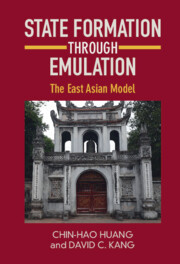Book contents
- State Formation through Emulation
- State Formation through Emulation
- Copyright page
- Epigraph
- Contents
- Preface
- 1 Introduction
- 2 Theories of State Formation and Diffusion
- 3 Phase I and Onwards
- 4 The Absence of Bellicist Pressures in State Formation, 400–800 CE
- 5 Phase II
- 6 Korea and Japan over the Centuries
- 7 Vietnam Emerges
- 8 Epistemic Communities and Regional Connections
- 9 Who Doesn’t Emulate?
- 10 Conclusion
- Appendix Major Events in Sinicization, 300–1100 CE
- Bibliography
- Index
9 - Who Doesn’t Emulate?
The Borderlands of the Central Asian Steppe
Published online by Cambridge University Press: 21 July 2022
- State Formation through Emulation
- State Formation through Emulation
- Copyright page
- Epigraph
- Contents
- Preface
- 1 Introduction
- 2 Theories of State Formation and Diffusion
- 3 Phase I and Onwards
- 4 The Absence of Bellicist Pressures in State Formation, 400–800 CE
- 5 Phase II
- 6 Korea and Japan over the Centuries
- 7 Vietnam Emerges
- 8 Epistemic Communities and Regional Connections
- 9 Who Doesn’t Emulate?
- 10 Conclusion
- Appendix Major Events in Sinicization, 300–1100 CE
- Bibliography
- Index
Summary
Why do some societies emulate a hegemon, while others do not? Why did most societies accept Chinese civilization while some resisted it, and why do some societies in general emulate a hegemon while other societies resist? Conversely, more rare were societies that rejected Chinese civilization. Located mostly on the sparsely-populated northern and central Asian steppe, some semi-nomadic societies did not see as appropriate or desirable almost anything about Chinese civilization: settled agriculture, written language, and territorial states. The contrast with Korea and Japan – and later, Vietnam – is clear. Culture, not geographic or material interests, explains why some societies did not emulate China.
- Type
- Chapter
- Information
- State Formation through EmulationThe East Asian Model, pp. 172 - 185Publisher: Cambridge University PressPrint publication year: 2022

